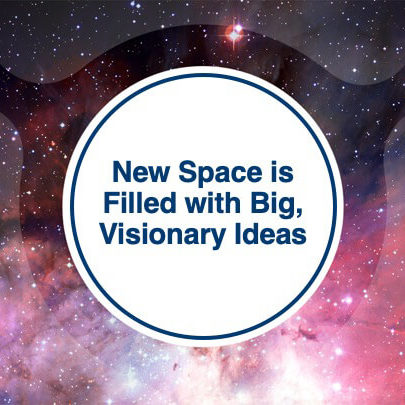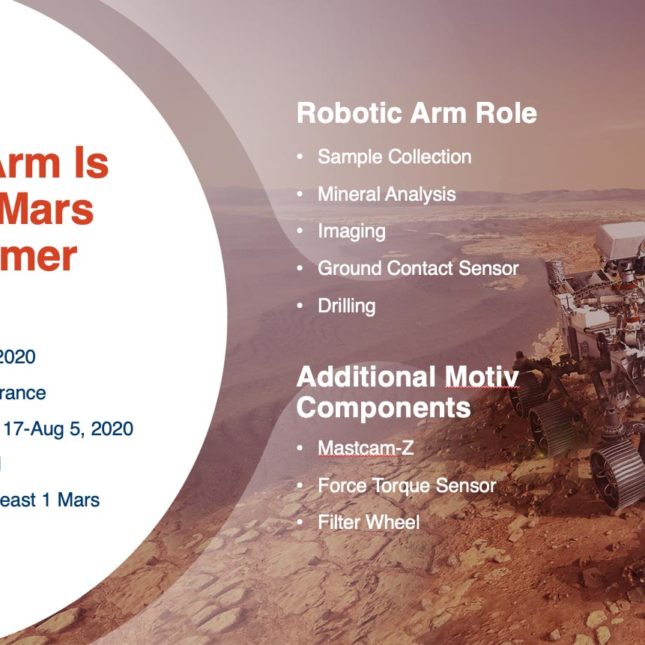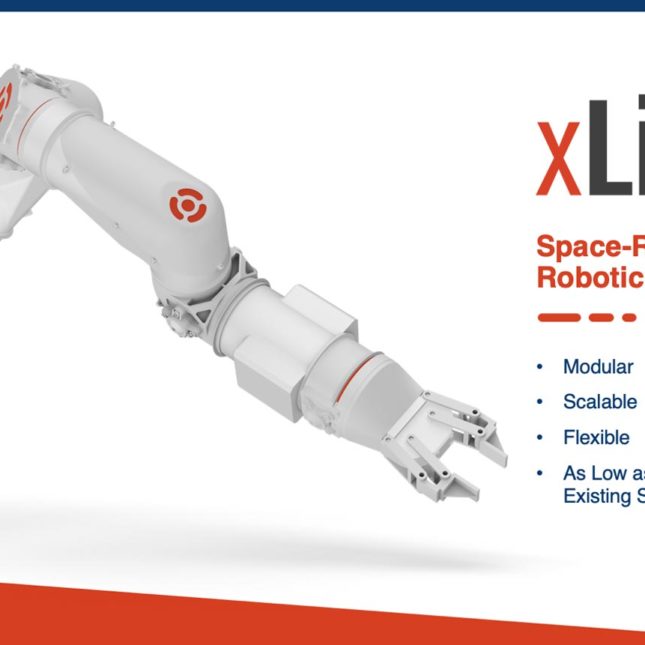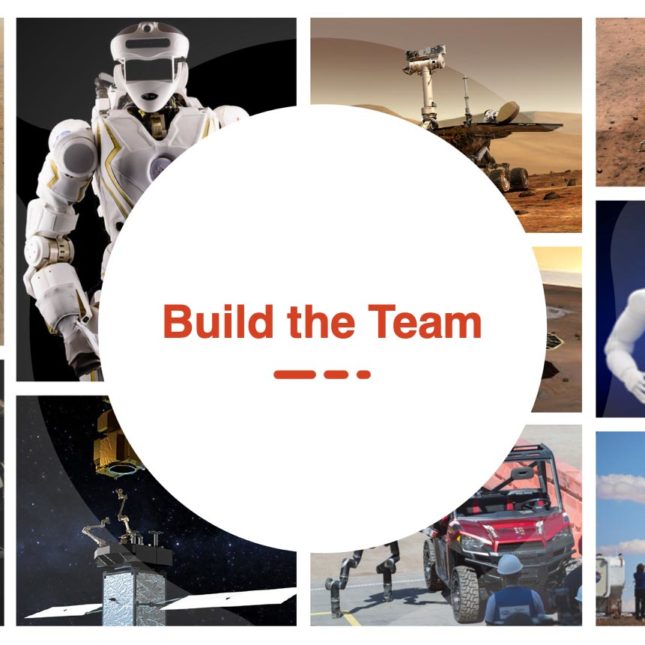Moving the Decimal Point for New Space
(Pasadena, California – Thursday, July 30, 2020)
Motiv Space Systems is committed to building tools that will enable visionary ideas for “new space” to succeed. The vision is to bring innovative solutions to both ground and space robotics.
In this presentation for Friday Coffee Meetup, Chris Thayer, President, CEO, and Co-founder of Motiv Space Systems gives an inside look at Motiv: who they are, what they’re doing currently, and where he sees robotics going in the future. In this video you’ll get a fascinating introduction to new space, and how the frontiers of new space require visionary ideas that are high-risk and often can’t be realized. Motiv’s sweet spot is to identify new approaches in ground and space robotics that can serve as a bridge to the best visionary ideas for new space and make those ideas come to life.
Whether navigating NASA contracts, commercializing advanced space robotics for the JPL Mars 2020 Perseverance Rover, or making accessible modular products such as the xLink system, Motiv is moving the decimal point for what is possible in new space. Think of Motiv like the pick-axe and shovel makers of the old Gold Rush days. They are enabling those missions to fly.
Adapting to New Space and Becoming Far More Accessible
In this video, you’ll learn more about how Motiv turns custom projects into products. Moving from custom, bespoke, one-off space robotic systems to reproducible product-oriented solutions, with every step they assemble new capabilities and new products. In this video, Chris describes the ins and outs of competing for a new program or developing a new product for the US government and the private sector. Motiv’s strategy is to leverage some future capability overall. Nothing is wasted: You’ll always find Motiv utilizing their current products and competencies. And those products and capabilities are undeniably cool.
Onward to Icy Worlds, Mars, the Moon…and Beyond
Chris highlights a number of incredible recently completed and ready-to-fly projects such as the Mars 2020 Robotic Arm, Robot Controllers for OSAM-1 (formerly Restore-L), a Cryogenic Filter Wheel, and Mars 2020’s Mastcam-Z, the first stereoscopic zoom camera on another planet! Each of these products do the work of enabling new space flight projects.
Watch to learn more about future space missions on the horizon for Motiv.
Q&A Transcript
Q: This is fascinating! I had a quick question before we launch into Q&A. So on the solar panels, did you say they’re being printed and assembled in space?
Chris: So, the actual photo-voltaic cells are rolled up on a roll, and…the structural part, that’s being printed out and that will just extend the roll out that way. Typical solar arrays are structurally rigid panels that get folded up, and that’s why it’s limiting for a small spacecraft. You can’t fit large solar arrays on the spacecraft like that, so this is a relatively innovative—well it’s very innovative—way of deploying a solar array.
Q: Okay fantastic. Our first question: How different are x-Linked and ground robotics?
Chris: So, that’s a great question. And that was one of the first things in that “aha” moment where we started looking at this. We said, “Well, wait a second.” We looked at that and we said, “Wait, that’s exactly what we need. What do we need to change to make that flight-worthy?”
And so, at the end of the day obviously there are a number of things that constrain you in space in terms of both computation and then materials and processing. But if you were to tear most of these things apart, they look fairly similar, and that’s a bit of a cheat on our side, because we come from building space stuff, so that when we build ground stuff it looks similar to our space stuff.
But primarily you’re talking about different materials, sometimes different sensing that you have to put in the actuators, and then obviously from a software and computer side that’s where things get real dicey, because you don’t have the same computational power that everyone’s desktop has right now. It’s hard to replicate that on orbit in an affordable manner, so that’s where things get more complicated. And you have to be very efficient in those areas on the space customizable robotics.
Q: What are the services those robotics normally provide, and who are your main targets for that?
Chris: On the xLink product line, really the initial customer base we’re targeting is more of a new space audience. Most of the NASA missions are fairly bespoke, or boutique kind of solutions for very specific cases. And a lot of times when we’re talking to new customers that are trying to go out and build a business case for a mission, or for a service that they’re going to provide, they need flexibility all the way through the development process because they’re still working out typically what’s going to happen and how it’s going to happen. So as they build that use case up, we need flexibility in the system which typically doesn’t happen on something like a government SYS procurement system, which takes years to get there.
And by the time you see it it’s very well thought out and very well documented, but that flexibility is needed on the new space side, and that’s primarily the target now. But we are talking with certain government agencies as well to deploy this system on some of their—let’s say—innovative platforms. And how do you decide which technologies to license that you’re going to go with? …So that’s actually really interesting. I think one of the lessons that I had learned over the years—and especially here—really you have to have almost someone who was embedded in the technology at some point in their career to actually be able to transition it from either an academic or government institution.
It’s very difficult to just take a cold piece of technology and then integrate it, so we’ve done that with a number of different products where we were familiar with them either in a past life or familiar with the people and so we had an easier path to transition that technology because usually it doesn’t come with a bow on top of it, all ready to unwrap and use.
You have to do some digging, and you have to invest a significant amount of time and effort into it, so you have to know that there’s value there. You can’t just go, “Oh that looks neat, I’m sure I can use that somehow.” You have to really have an understanding, otherwise you can waste a significant amount of time.
But like I said with our building block approach, we like to make sure that when we see something that we want to integrate, it has not only use for today, but use for tomorrow, and how we would build that into a product line, or really augment a whole suite of products. And in that product process you know to fund that.
Q: How did you finance your company’s launch?
Chris: So we actually were internally funded, and we didn’t take any external VC money or angel money, and so that was very fortunate to be able to do that, and we were profitable from the first month we were in business, so that was a unique situation. I’m fully aware of that, but we’ve been pretty happy with our ability to do that.
Q: That’s fantastic. Some of the robots you showed at the beginning of the talk had very humanoid forms. Would you be able to elaborate on your thoughts on form and function?
Chris: Let’s see. So yeah, some of the things that you were seeing were from people that worked at Johnson Space Center, and that included Robonaut and Valkyrie, two humanoid form-factor robots. Those are obviously very interesting, primarily because if you’re going to do things in a human environment, that environment’s designed for (shocker!)…humans. And so if you can develop a robot that can interact with the world much the way the same that a human does, then that’s advantageous.
The problem being is humans are really amazing, honestly, in terms of both locomotion and dexterity and how they interact with the world, so it’s still a big challenge to make a robot that can mimic the nuances of a human form-factor. So, you see…things that are more direct, like a rover like you see on the screen, now that’s obviously a very purpose-built robot and it’s built more like a robot for doing robot tasks.
So, I think there’s still ongoing research and it’s an exciting area for sure, but for a while we’re still going to see a lot of the robots that we depend on to do tasks look more like a classical robot would look. And eventually I think that the humanoid form-factor in the robots will also catch up. The biggest issue with that is power. A wheeled robot is much more power-efficient than a walking robot currently, and so that’s really something that is difficult to change.
Q: And next we have a technicalist question: How do you compensate for angular momentum when manipulating an arm in space?
Chris: Oh, that’s a good question…so, there’s a number of different ways, but typically you have reaction wheels on the spacecraft that counteract those motions of the robotic arm. But it’s a dance that you have to be very careful with, especially on something like a small spacecraft, where the robotic arm and its momentum can actually be a significant percentage of the host spacecraft, if you will.
So, you have to control your rates and exactly what you’re doing and when you’re moving and how you’re moving, as you don’t saturate your reaction wheels. And this is a real issue that you have to kind of really take care of, and mind that you can think of momentum as a resource on orbit. And you have to mine that carefully.
Q: In the beginning of the presentation you talked about some solutions for space debris removal. Can you talk a little bit about that part of your work?
Chris: There’s a myriad of different debris that’s especially in low earth orbit, and it’s becoming an ever-greater problem. Now, we don’t do space debris removal per se, but one of the things that you have to look at is how do you get large, spent second stages that are floating around? There’s everything from paint chips floating around at thousands of miles an hour, all the way to very large multimeter sized chunks that are floating around up there.
And this constant debris issue is something that’s very active, and not only the U.S. kind of community, but also globally. And there are a number of companies that are going after this to do debris removal. One of the challenges of that is that, as an example, if the Russians launch a spacecraft and they have a second stage that’s sitting up there, that’s still considered Russian property. So you cannot go as a U.S. company, and go grab that and throw it away. That’s a treaty violation, so there’s a lot of complexity that goes beyond just the complexity of going up and grabbing something and disposing of it. There’s also the complexity of international treaty law that goes along with that, so there are a number of people looking at that, but it’s still a very fledgling activity.
And to date no one’s really actively cleaning up the orbits as we speak, so that’s something that I believe will have to happen at some point: how it happens, and who pays for it—that’s a different question.
Q: Okay and that treaty law…I’m assuming there are groups looking at that and how that’s going to evolve as we go forward?
Chris: Yeah there are definitely people looking at that, but I don’t know how much activity there is on changing any of that, as we speak. But there are definitely passionate people. I’m trying to move the needle on that.
Q: For sure, OK, and is your xLink arm a candidate for a payload on an upcoming NASA commercial lunar landing mission, robotic, or human lander?
Chris: So, that one we’re actually trying to look at some of those clips/missions going forward, and we’re hopeful. We have a candidate for that outside of that. One of our other products is going to be on a lunar eclipse mission too for a robotic arm that we’re developing that we’ll be announcing soon, so we’ll also be hopefully going to the moon here shortly with a robotics system that’s going to be very unique. I can’t say more than that right now, but it should be great.
Q: How do you design electronics for different application areas like Earth, orbit, Moon, and Mars?
Chris: Speaking of the moon, right, so that’s obviously very interesting. One of the things that we tried to do—because again you have to do a lot of validation work on the ground before you’re either in orbit, or Mars, on the Moon—and so to do that…because flight electronics and flight hardware just in general is so expensive, they end up using hardware that’s not the same in early testing.
So what we tried to do was make sure we had a design that actually had everything from commercial grade hardware all the way through flagship, you know, Class-A mission hardware that was the same as you were always testing on the same type of system—the same system essentially—so as you build up from your lab all the way through to flight all that work is relevant. You’re never really breaking the chain of that hardware or that system as you go through that process.
The big thing is obviously the killers are for electronics. You’ve got your radiation environment, which goes from fairly benign environments and certain LEO applications all the way to basically almost impossible out in the Jovian moons, out there. So, you’ve got this range of radiation as a huge issue and then you’ve got also the temperature fluctuations, and sometimes everyone wants to focus on the cold part of it. That’s a real thing. But sometimes when we’re using arms or we’re using electronics, actually getting heat out of them is hard, too. So, that’s really the hard part.
And then there’s mission duration, so a lot of the Missions Cube SAS and the like, they can use fairly low grade commercial parts because they only have to last for a few days or a few weeks. But if you want to last for 15 years in a radiation environment, you have to basically buy very expensive parts that can work in that have been screened and you can have confidence in, so it’s really quite a challenge to build an electronics package that can be affordable at all those different areas, but is adaptable enough to be able to be housed and utilized in all those areas as well.
Q: Great! And then can you talk a little bit more about testing your products to qualify and certify them for space environments? What capabilities do you have to have. What does that look like?
Chris: Sure. So, a lot of times just the simple infrastructure things you need to have a bunch of processes in place. You need to have equipment clean rooms, things like of that nature, and then as you go through the process, different things require different testing services. But you’ll go through thermal testing, you go through maybe thermal vacuum testing where you’re putting it into a system, into an environment that’s similar to what you would find in space, all the way to if you really have a particular case that needs it.
You can have a sun simulator on one side, and a cold bank on the other side to see what that thermal gradient is in a thermal vacuum situation, and then you do maybe some static testing where you put loads on things to test their structural capacity, and then all the way through vibration testing where you shake it.
The old adage is, “You don’t build spacecraft. You build launch craft.” Because you build the spacecraft to really survive the lows that are imparted during the launch. It’s not so much space. Once you’re in space, the loads actually drop quite a bit, so you test all of those things and it’s a “test as you fly, fly as you test” mantra, so you go through this process of “test it as it’s going” to see its environments. And then you fly it just like you tested it, and then that gives you confidence that the system will work.
Q: Okay, thank you. Can you talk a little bit about government, what the government-private relationship looks like and where you think it will go in the future, as well as kind of those implications around ownership: how resources are used? Then, any things that you learn or discover.
Chris: That’s a lot, let’s remind me.
Q: Well, let’s start with government. Can you discuss the kind of government relationship versus the private relationship. Can you talk about what you think it might be evolving to in the future? How between how it looks now?
Chris: Yeah, I think over the past decade or two you’ve seen a definite bent towards having what they call a “public-private partnership” and in a lot of these contracting models you see that. Even today, with the Artemis HLS system, that gets back to the model where there’s a public-private partnership, and most notably you saw that in the launch the other day of two astronauts to the ISS on the SpaceX launch vehicle. So, there’s definitely a much tighter integration between NASA or the DOD and private companies.
And I think that will only grow because there’s significant value there for both parties. If leveraged properly I think that’s a great thing and I also see that…another shift that’s happened is more of a desire to buy products so as they have a need or a mission, or something. Whereas maybe 30 years ago would have been, “Let’s start from scratch and a clean sheet of paper” to now it’s, “What’s out there? What can the commercial sector give us today, and how do we adapt that for our use?” which is a pretty seismic shift, I think.
And that makes it more in line with how you interact with a commercial company, so…those things are becoming more similar rather than more dissimilar. And then as you’re working together, the implications around ownership—how resources are used, and then intellectual property—things that are learned or discovered going forward, sure, honestly, the government’s great about intellectual property. And especially if you’re a small business, they want to foster as much ownership of the IP that you’re generating as possible so you can be successful: leverage that, commercialize that…and I might get pilloried for this, but one of the best investors you’ll find is the U.S. government. They have belief in you, and they want you to succeed, and they’re a great partner for growing your business.
And if you play nicely and complement that with industrial work, and working with private companies, you can really foster some pretty powerful things.
Q: So, okay, great. We had a lot of questions today, but I’m going to wrap up with one looking towards the future. Are there any advancements in emerging tasks that will enable space robotics or travel in new ways that you’re looking forward to?
Chris: Yeah, so, I think, you know, that it takes a long time for this stuff to kind of work its way through the system, and a lot of the areas that we can really start to leverage are in computation. And then the electronics side of things and then along with that are things like autonomy in the robotics side.
There, just as an example, it’s a 20-minute delay for comm to Mars, so by the time something’s happened, by the time you see it happening, it’s already done. So the more you can push autonomy onto systems in space, the more you can do when we look at things like doing construction on the Moon. We’ll want to have a vast array of robots doing construction, but you can’t have a person managing every robot. But it becomes pretty onerous, so if you can start to have deployment of autonomous systems that are doing tasks and then you have that modularity. And you have powerful electronics that the chip makers are actually developing new products for space, which is exciting, and then companies like ours can leverage those and really build out products that are powerful.
So, those are areas where I really think there’s going to be kind of a transformation—and I see it as a cooperation model between robots and humans, especially on places like the Moon, where you can’t have a human presence all the time doing work, and it really can put the burden of doing kind of the heavy lifting on the robot—and then have the astronaut up there to make the decisions really using the strengths of each one: use the decision-making strength of the astronaut and the dull, dirty, dangerous capability of a robot to be out there and doing that work…so that’s kind of what I hope for.
Christy: Fantastic. You know we were going to kind of conclude Q&A now, but did this bring up any other comments that you want to share, or is there a way that our community can help support you?
Chris: I think we’re always looking for new ideas, and obviously one thing we’re always in need of is great robotics assists and robotic software engineers. So, is there any of those people listening? Contact me.
Yeah, I think that this is kind of a new kind of age of being able to do this stuff, and I’m excited that maybe we’ll get to go play on the moon soon. And I’m really hopeful for that, and I hope everyone watches the launch coming up here, end of July. So anyway, thank you.
Christy: Fantastic, so he is hiring. We did get that as a question…reach out to him, check their website.
…Thank you so much, Chris, this was fascinating. Our people on the chat and in the questions, there were so many more questions that we couldn’t get to, will you be able to stick around with us for a little bit for open networking?
Chris: Sure.
Christy: Ok fantastic.



